Sebastopol, CA and Peru
Scott Leonard is the co-founder and CEO of Indigenous Designs, a fashion company specializing in fair trade and organic apparel. They sell direct to consumer, but also white label their apparel to major brands such as Eileen Fisher. Their model is to alleviate poverty by creating jobs in the BOP, the base of the pyramid. Indigenous works in economically marginalized communities to create opportunity for women and men. Today, Indigenous currently engages over twelve-hundred artisans in their supply chain. They are all about poverty alleviation and creating opportunities in economically marginalized communities. Scott has worked for years on creating an ethical sourcing model, developing a rich community of suppliers, educating others in the apparel industry and now participates in changing industry standards by changing the landscape of apparel manufacturing globally. Indigenous is part of a greater conversation with The Sustainable Working Group, a multi-stakeholder group of brands that have gotten together and indexed the goings on within the apparel industry.
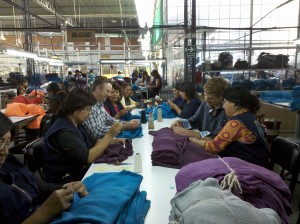
Matt and Scott, Indigenous Founders working at a Quality control table at one of our partner facilities in Peru
______________________
Amy: What do you get from working with local artisans and a supply chain featuring organic materials? Scott: When I think about the Indigenous supply chain, it goes all the way from the organic cotton field with the farmer, right back to the artisan who’s actually either hand knit it or used a lap loom machine without electricity to create the fashion that we produce. It’s an amazing journey from fiber, to the actual product, to the store. We love to connect the consumer to the fact that everything’s made ethically, the fact that everything’s made organic, and the fact that everything’s made with fair trade in mind. A: You’re talking about raising people out of poverty. Correct?
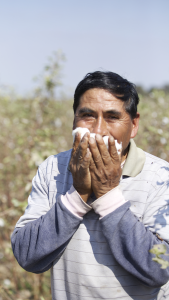
One of the farmers in our supply chain smells the beautiful organic cotton flowers.
S: At Indigenous Designs, we take a systemic approach, all the way from the field to throughout the supply chain, looking at how the community is benefiting. And it’s not just one touch point, it’s all touch points. We, of course, have to look at income and what it means to have fair living wage. That’s one way that we can assess how people are doing. We also take a look at what we call “indicators”. For instance, Grameen Foundation has something that’s called the PPI, it’s the People out of Poverty Index. It really gives us certain indications on how someone’s doing against that poverty line, so we might ask the question like, “Do you own a refrigerator?” But in reality if you own a refrigerator, it tells us a lot more than just that you own a refrigerator. It means you have electricity, it means you’re thinking about meal planning. It means that you actually, of course, have the income to buy something like that. There’s even an attached KPI to the indicator that there’s a hardwood floor that the refrigerator will sit on that actually sets off other indicators. So, there’s a series of questions we can actually ask within our supply chain to see how people in our community are doing. That’s just one way that we’re looking at the supply chain. We’re always interested also in literally how much people are making, and one of the ways that we will look at is the living wage. We ask the question, how much more over the living wage are they making within the community? And living wage is often very different than, say, minimum wage. Every community is going to be different, right? Every community is different. Maybe here where we work in Sonoma County California, the minimum wage might be around ten dollars an hour. But the living wage in our county is more like $12.50 an hour, so you have these ways of looking at this throughout the globe to make sure that people are able to buy basic necessities and be above that poverty line, and do okay in their life. That’s what we’re trying to create–the opportunity for people to do well within our supply chain across the board.
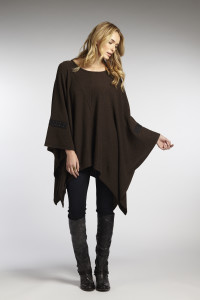
A poncho from our Fall 2015 line.
A: Where is your apparel available? Do you work with other stores? S: Indigenous is available in about 500 stores across the United States. We also sell our product online, but we’re primarily a wholesale company. We go to all fashion shows, the buyers come to our booth, and they’ll write their orders and then we produce it for them. We also do private label. Private label would be our supply chain–all sustainably made, fair trade and organic–but with another client’s label. One of our best customers is actually Eileen Fisher and they’re an amazing company to work with. They have the same kind of value set we do. So we’re able to work with them and produce thousands and thousands and thousands of garments within our supply chain each year that actually create jobs and benefit people and their well-being within the communities that we work. A: Let’s talk about the influence within the fashion world you’re having, because fashion is notoriously myopic and self involved, divorced from creating wellness for people. Can we talk about that relationship? S: You know as a smaller company, Indigenous is definitely not this huge global brand right now, but we have a loud voice. And we like to believe that we’re catalytic, if you will, that we have a catalytic voice. That’s one of the things we’re proud of…being part of a larger conversation–you know, yelling across the the water, so to speak, that people can be treated correctly, people can be treated well, the environment can be treated well, and we can still be a profitable business. That’s why we stand a beacon as Indigenous does within the fashion community; because–let’s face it–the fashion industry has been notorious for not being so great to people and the planet. We think of places like with Bangladesh, where recently workers’ rights were violated, where peoples’ safety has been compromised. We want to bring attention to that. And we actually believe very much in collaboration, so that’s what Indigenous has been about– being a smaller brand getting larger brands to the table to talk about all these issues. Right now, we believe we’re actually changing the face of the fashion industry. An organization out there right now doing a great job are SAC, the Sustainable Apparel Coalition, bringing together larger and smaller brands into conversation about sustainability, about human rights. Certainly, all of this adds up to a better industry. The apparel industry as it stands right now is, I believe, the second most polluting on the planet. Then when it comes to human rights violations and human trafficking, all sorts of really horrible conditions to work in, the apparel industry is right up there with the worst of them. We’re honored to be leading the charge in bringing people to the table, and to talk about this important issues.
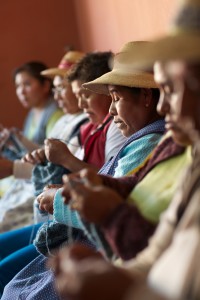
Eva and her knitting group.
A: Could you give me an example of your success in influencing business and global supply chain? S: One of the things we’re proud of is being part of the Eco Working Group, which is now actually named The Sustainable Working Group. This is a multi stakeholder collaboration of great brands like Prana, Patagonia, Indigenous, Timberland–all getting together to figure out how we can tackle sustainability, sharing best-in-class practices. This group has gotten together into smaller groups that deal with chemical, fair labor practices, packaging–getting everybody together to share those best practices and encapsulate it into an index. That actual index was acknowledged by the Obama Administration and has led to further collaborations, including The Hague Index, which is now used by SAC, which is Sustainable Apparel Coalition, representing almost 50 percent the apparel made on the planet. So if you think about changing the way we think about apparel and and moving the needle on sustainability within the fashion industry, I think these are a couple of things that are really big news for people to know that we’re working on altogether. Indigenous Designs is definitely proud to be a founding member of these groups. A: You mentioned fashion is one of the most polluting industries in the world. You can clarify, is it the dye, or the fabric? How does creating apparel create waste? S: When we talk about supply chain in the apparel industry, often we’ll talk about what kind of dyes are going into the clothing and about using sustainable dyes, natural dyes and things that maybe don’t have heavy metals in them. Water management and water waste–just polluting water in general when it comes to dyes is a huge problem on the planet right now. Especially in the apparel industry where there’s been a really bad track record about about water waste and touching people–literally. So when we talk about the toxic types of chemicals like azo-dioxin, it’s been used in different types of dye. I’s really detrimental to people’s health, and there’s a big problem in China when it comes to the water that’s literally coming out these mills and making entire rivers different types of colors with lots of sludgy types of materials. So, there’s a lot to clean up that needs to happen. I think if you focus on companies that are out there like Blue Sign that are really trying to guide the experience around dyes and ecotechs, these are companies that are really trying help guide larger apparel discussion around more safe dyes to wear on one’s clothing. A: Tell us about waste streams in term of fabric.
S: There is so much waste in the apparel industry when it comes to leftover fabric. This is what goes into our landfill. There is a big discussion about how do we actually stop consuming so much and how we get more efficient with the fabrics and the materials that we actually put into those fabrics? If you can even just think about cotton and how much use cotton gets, it’s concerning. Cotton is one of the most polluting plants on the planet. It’s so toxic and when it comes to a good way to do it, we can actually just use organic cotton, which means it’s pesticide free. Not to be doom and gloom, but you know 10,000 people a year die from pesticides exposure on the planet. That’s a fact from Pesticide Action Network that has been ongoing the last 10 years. So we’re not talking about a few peoples’ lives that are affected, we’re talking about literally 100,000 or more people in the past 10 years that are touching pesticides to provide the clothing that we wear. The solution is really simple–just buy organic cotton. A: Can we talk about the tons of waste and solutions to avert the issues we are facing? S: There’s a lot of innovation when it comes to what we do with leftover fiber. When you put something on what we call a cutting table, it’s almost like a fabric that lays on a table and you cut that circle. It’s almost the same thoughtful approach as making cookies–what happens to the rest of the cookie dough, right? What do you do with that? Well, when you make cookies. You can roll it all back up and make another cookie. Not so easy with apparel. So what we’ve found is that there are a lot of companies now that are actually starting to recycle and re-churn that material–and then put it into all different types of things. There are a lot of great examples out there for reusing materials to use in other ways, like putting into car seats. Companies are now even re-spinning that into into fiber to make into another t-shirt, sweater or jeans-anything of that nature. There’s a lot innovative work being done, but the problem is pretty exponential that we face on the planet. We’ve got to keep at it and keep innovating. A: Any wishes of what the future could be if we practice these things?
S: One of the things that we’re doing that we feel is special is connecting the artisan who makes our apparel to the consumer, creating that bridge that people can relate to the people making their garments. We’ve got something called the Fair Trace Tool. On each one of our garments there is a QR code you can scan. When you do, up will pop information about the community that’s actually made that item. There’s a little google map on there where you can go into the community and even track a little bit of what we call the SROI, the Social Return On Investment–what’s the impact that’s actually being made within that community. We feel like that’s something special we’re doing to go a step further. We’ve been using that same cell phone technology, not necessarily a smart phone, but actually like basic phones within the supply chain to actually ask messages–both through voicemail and texting directly to the artisans and the people that are in the supply chain. We ask questions like, ‘Do you feel like you work in a safe and participatory workplace?” And that’s golden because they’re actually able to answer truthfully by not necessarily have someone looking over their shoulder. All different types of what we consider human rights violations can be actually limited by using, sort of serving through technology itself. That’s going to cut down on human violations and hopefully we can end slavery within the actual supply chains that are out there in the world, in the apparel industry, in the electronics industry. ______________________________________________
LEARN MORE
Interested in buying clothing from Indigenous Designs? Visit their website www.Indigenous.com
Follow us Twitter.com/NobleProfit
Learn more about sustainable business solutions that are also helping the world by registering at Noble Profit.
Noble Profit is brought to you by Creative Entity Org and Creative Entity Productions created by Amy Seidman.

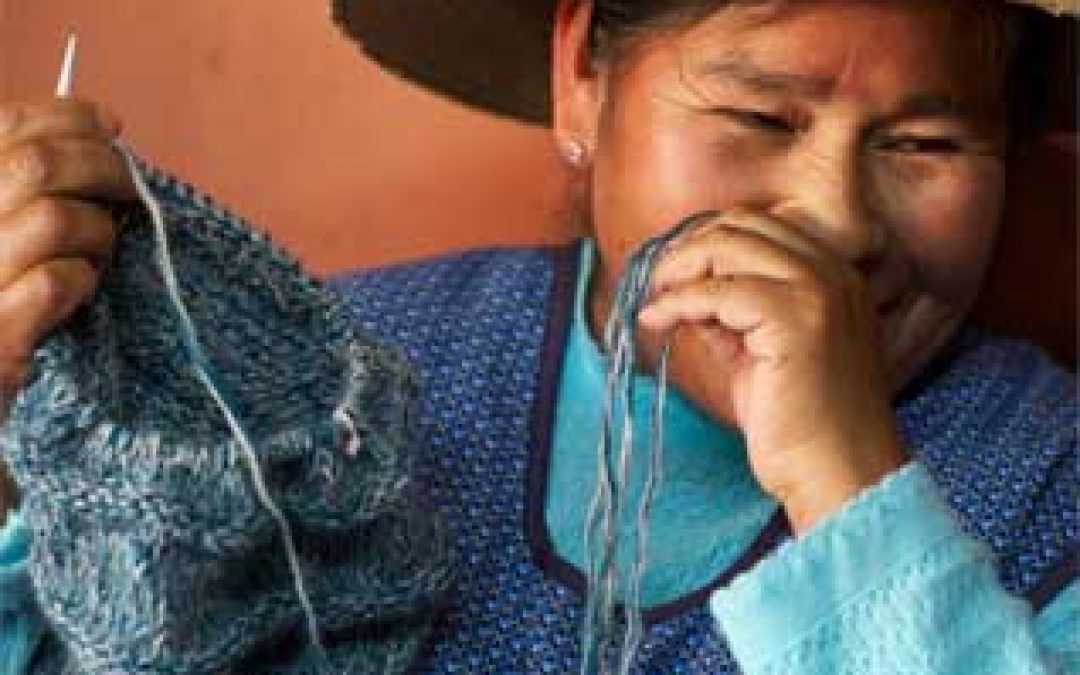
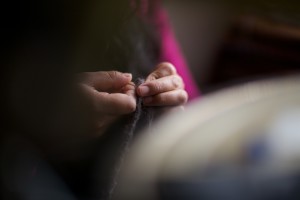
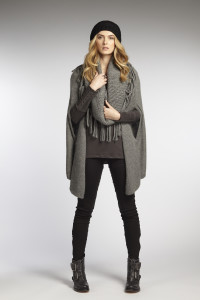
 Noble Profit™ is an authentic source for discovering innovation, trends and investment in clean tech, and sustainable business.
Noble Profit™ is an authentic source for discovering innovation, trends and investment in clean tech, and sustainable business.